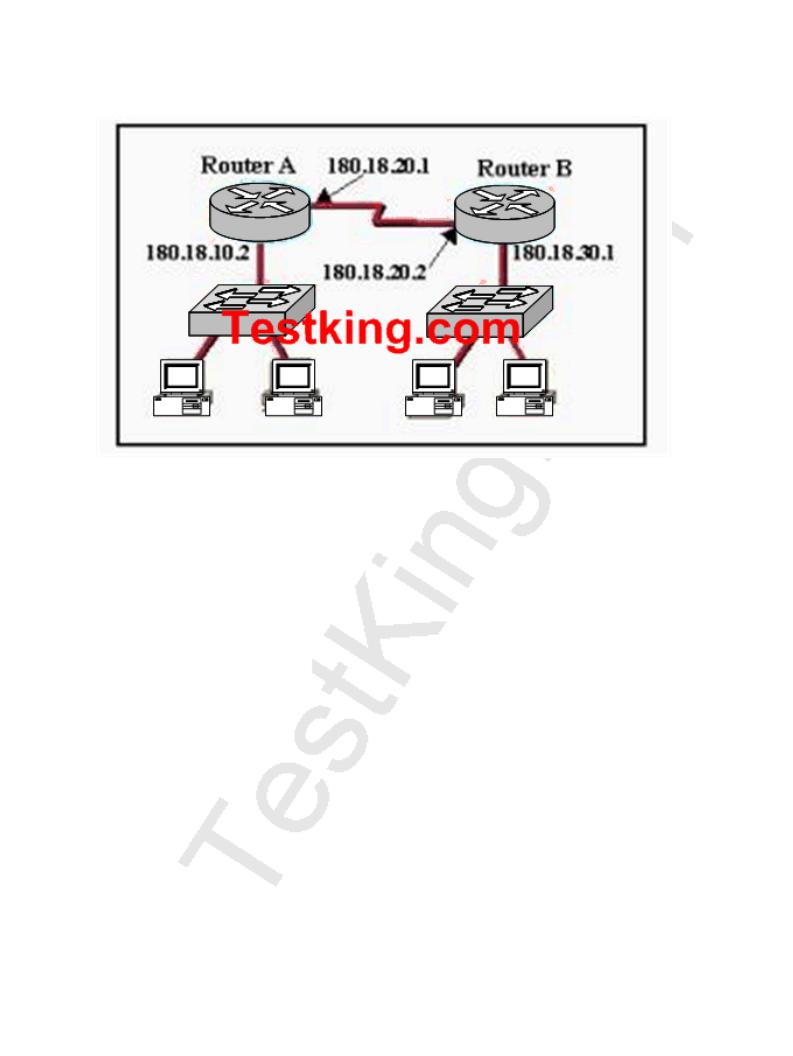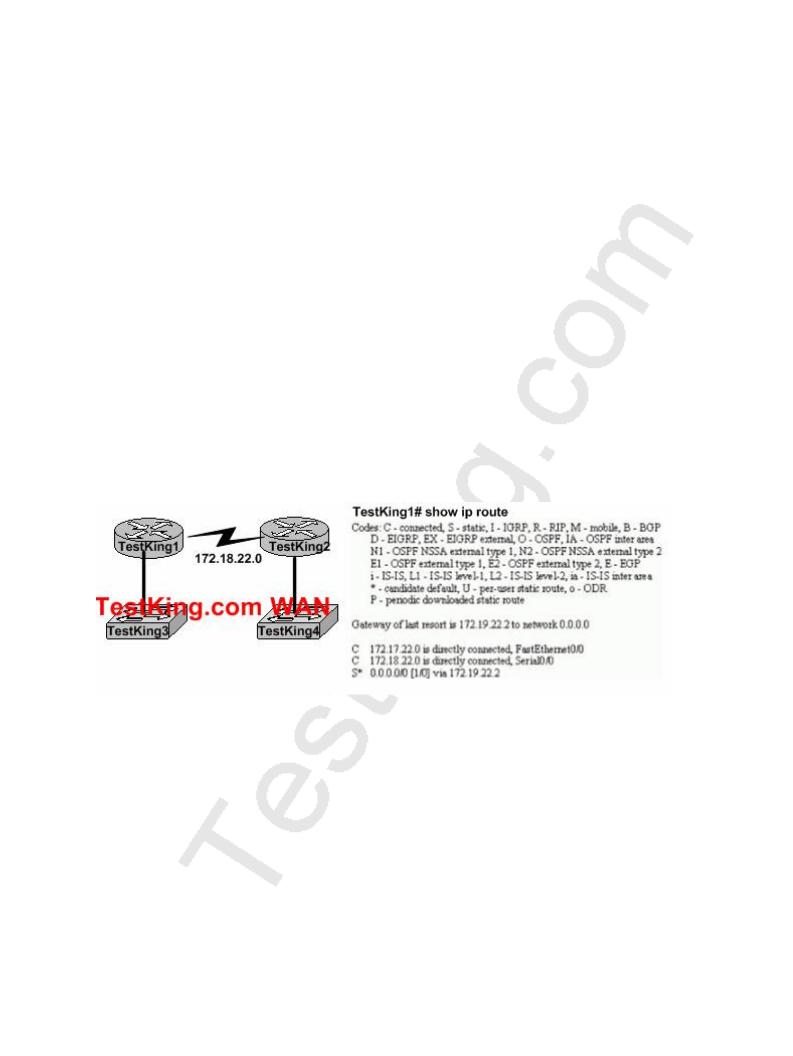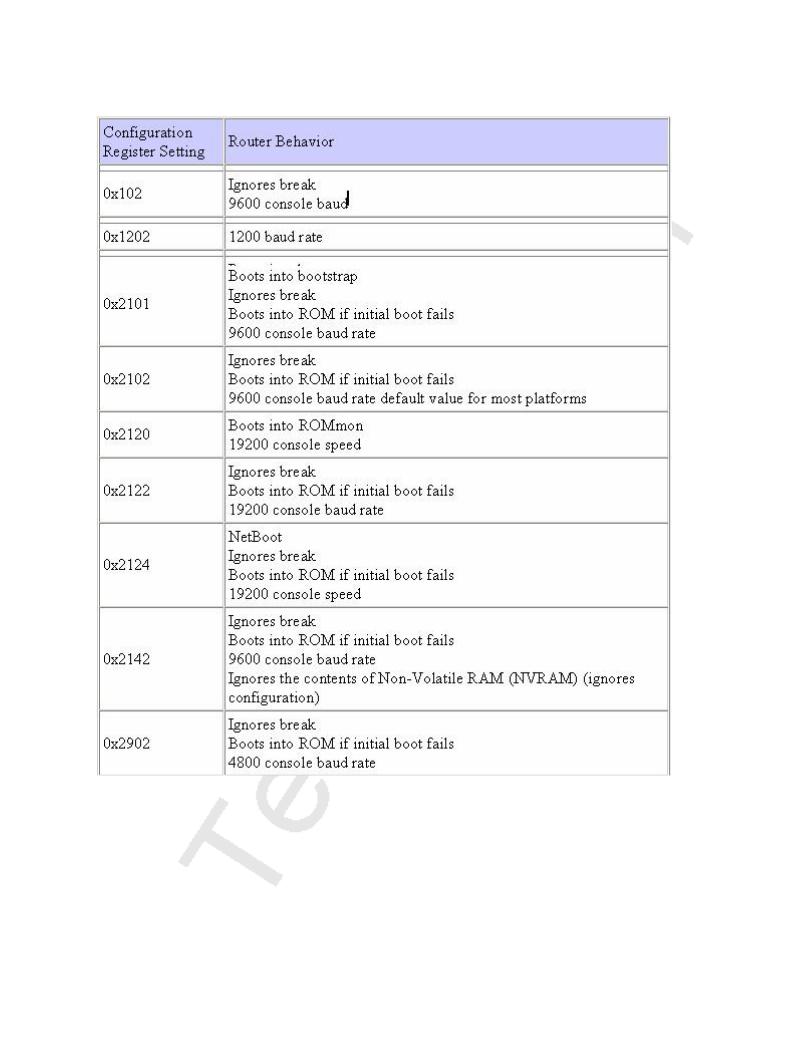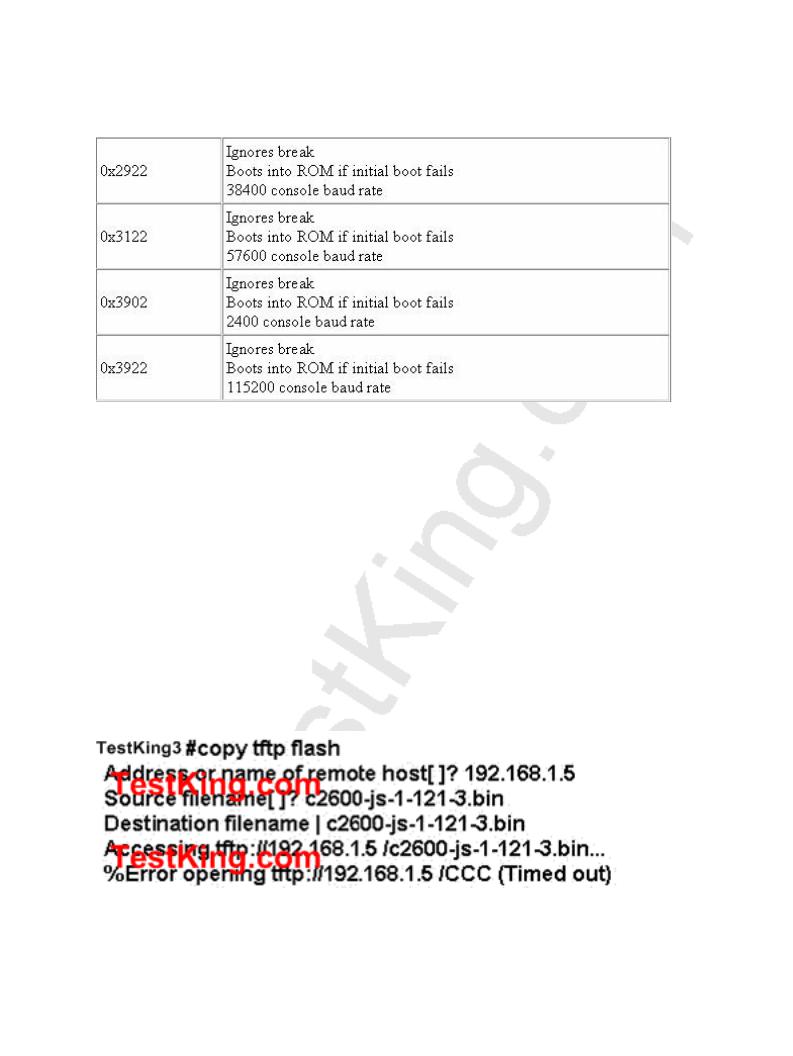
Testking_640-802_V13
.pdf
Based on this information, which of the following will configure a static route on Router A to network 180.18.30.0/24 with an administrative distance of 90?
A.Router(config)# ip route 90 180.18.20.1 255.255.255.0 182.18.20.2
B.Router(config)# ip route 180.18.20.1 255.255.255.0 182.18.30.0 90
C.Router(config)# ip route 180.18.30.1 255.255.255.0 182.18.20.1 90
D.Router(config)# ip route 90 180.18.30.0 255.255.255.0 182.18.20.2
E.Router(config)# ip route 180.18.30.0 255.255.255.0 182.18.20.2 90
Answer: E Explanation:
Static route entries consist of the destination IP network address, the IP address of the next hop router, and the metric (hop count) for the route. A static route that points to the next hop IP address has an Administrative distance of 1. If the static route points to an outgoing interface, the static route has the Administrative distance of 0.
One common reason to change the administrative distance of a route is when you use Static Routes to backup and existing IGP route. This is normally used to bring up a backup link when the primary fails. In this example, choice E specifies that to reach the 180.18.30.0/24 network, forward this traffic to the router with the next hop IP address of 182.18.20.2 (Router B) using an administrative distance of 90.
Leading the way in IT testing and certification tools, www.testking.com
- 401 -

QUESTION NO: 6
The network administrator of the Oregon router adds the following command to the router configuration: ip route 192.168.12.0 255.255.255.0 172.16.12.1. What are the results of adding this command? (Choose two.)
Exhibit:
A.Traffic for network 192.168.12.0 is forwarded to 172.16.12.1.
B.This route is automatically propagated throughout the entire network.
C.Traffic for all networks is forwarded to 172.16.12.1.
D.Traffic for network 172.16.12.0 is forwarded to the 192.168.12.0 network.
E.The command invokes a dynamic routing protocol for 192.168.12.0.
F.The command establishes a static route.
Answer: A, F
Explanation:
In order to configure a static route the router has to be in global configuration mode. ip route network prefix mask {address | interface} [distance]
network - the destination network
mask - is the subnet mask for that network address - IP address of the next hop router interface - or the interface the traffic is to leave by
distance - (optional) the administrative distance of the route
There are other parameters but these have been removed as they are not relevant to the CCNA exam.
Leading the way in IT testing and certification tools, www.testking.com
- 402 -

Example:
ip route 10.0.0.0 255.0.0.0 131.108.3.4 110
10.0.0.0 is the destination network. 255.0.0.0 is the subnet mask for that network and 131.108.3.4 is the next hop for the router to use. The 110 is the administrative distance which we will look at later on.
QUESTION NO: 7
Which of the commands below can you use to configure a default route on router TK1? (Select two answer choices)
A.TK1(config)# ip route 0.0.0.0 0.0.0.0 E0
B.TK1(config)# ip route 0.0.0.0 255.255.255.255 S0
C.TK1(config-interface)# ip route 255.255.255.255 0.0.0.0 192.168.1.21
D.TK1(config)# ip route 0.0.0.0 0.0.0.0 192.168.1.21
E.TK1(config)# ip route 0.0.0.0 192.168.1.21 255.255.255.255
F.TK1# ip default-network 0.0.0.0 192.168.1.21 255.255.255.255
Answer: A, D
Explanation:
There are two ways to specify a default static route. One is to specify the interface to use for forwarding packets, like the example in A. The other way is to specify the IP address of the next hop router, such as the example in D. The ip route 0.0.0.0 0.0.0.0 command uses the fact that network 0.0.0.0 is used by Cisco IOS software to represent the default network.
Reference: CCNA ICND Exam Certification Guide By Wendell Odem Pg.524
Incorrect Answers:
B.All zero's must used for the subnet mask of a default route, not all 1's.
C.The default route is made in global configuration mode.
D, E. A subnet mask is not needed after the next hop router is specified.
QUESTION NO: 8
Which of the following commands would you use to configure a default route to any destination NOT found in the routing table of router TK1?
Leading the way in IT testing and certification tools, www.testking.com
- 403 -

A.TK1(config)# ip default-route 0.0.0.0 255.255.255.255 s0
B.TK1(config)# ip route 0.0.0.0 255.255.255.255 s0
C.TK1(config)# ip default-route 0.0.0.0 0.0.0.0 s0
D.TK1(config)# ip route 0.0.0.0 0.0.0.0 s0
E.TK1(config)# ip route any any e0
F.None of the above
Answer: D Explanation:
Choice D is the correct syntax for configuring a gateway of last resort. Note that an alternative way is to specify the IP address of the next hop router, for example, "ip route 0.0.0.0 0.0.0.0 10.1.1.1."
QUESTION NO: 9
The topology of the TestKing network is displayed below, along with the routing table of the TestKing1 router:
172.17.22.0 172.31.5.0
Changes to the TestKing network were made, and now users on the TestKing3 LAN are not able to connect to the TestKing4 LAN. Based on the information above, what could be the reason for this?
A.The Fast Ethernet interface is disabled.
B.The neighbor relationship table is not updated.
Leading the way in IT testing and certification tools, www.testking.com
- 404 -

C.A static route is configured incorrectly.
D.The routing table on TestKing1 is not updated.
E.IP routing is not enabled.
Answer: C Explanation:
On the bottom line of the command output for 'show ip route' you can see that there is an asterisk by the letter S. The S stands for static route, and the static route is incorrectly configured.
Incorrect Answers:
A.If this were true, then the users on the LAN would be unable to connect to anything outside of their own network.
B.It appears that only a single static route is being used on the TestKing1 router. Neighbors do not need to be established for static routes.
D.The routing table consists of a single static route, which is configured incorrectly. The routing tables do not become updated dynamically when static routes are used.
E.This is not true, as a static route has been configured.
QUESTION NO: 10
Some of the TestKing routers have been configured with default routes. What are some of the advantages of using default routes? (Choose two)
A.They establish routes that will never go down.
B.The keep routing tables small.
C.They require a great deal of CPU power.
D.The allow connectivity to remote networks that are not in the routing table.
E.They direct traffic from the Internet into corporate networks.
Answer: B, D
Explanation:
Routers use default routing as a last resort when all other methods (directly connected, static, or dynamic) have been exhausted. For stub networks, a single default static route could be used to provide connectivity to the entire network. This is desirable for stub networks where only a single link connects the remote location to the rest of the networks. Because all of the traffic only has one link to use, a single default route will make the routing table as small as possible, while providing for connectivity to networks not in the routing table, since as traffic destined for the Internet.
Incorrect Answers:
Leading the way in IT testing and certification tools, www.testking.com
- 405 -

A. Although default routes are normally statically assigned, these routes can still go down. If the interface used as the default route should go down, or the next hop IP address of the default route become unreachable, the static default route will go down. C. Using static routes, including default routes, is the least CPU-intensive method of routing.
E. To influence the way incoming traffic from the Internet gets to a corporation, BGP routing would be used, not default routing.
QUESTION NO: 11
You have just configured a static default route on router TK1. What is the purpose of a default route?
A.It is a route to be used when the routing protocol fails.
B.It is a route configured by an ISP that sends traffic into a corporate network.
C.It is a route used when a packet is destined for a remote network that is not listed in the routing table.
D.It is a route manually configured for a specific remote network for which a routing protocol is not configured.
E.It is used to send traffic to a stub network.
F.None of the above
Answer: C Explanation:
Every IP host needs to have a default route either manually configured or dynamically learned. Default routes provide end hosts a way out of their local subnet and routers with a router of last resort if no other route (specifically relating to the destination) exists in the routers route table.
Routers use default routing as a last resort when all other methods (directly connected, static, or dynamic) have been exhausted. Routers inspect received datagrams to identify the logical Network layer address of the ultimate destination. If a directly connected static or dynamic route exists within the router's route table, it forwards the datagram.
If the destination remains unknown, that is, no method of routing has resulted in a learned route; it forces the router to use a default route. Typically, administrators implement default routes on point-to-point (a link with only two routers) or dial-up connections, linking TestKing.com's network to the outside work.
Reference: http://www.informit.com/articles/article.asp?p=26129&seqNum=4&rl=1
Leading the way in IT testing and certification tools, www.testking.com
- 406 -

Section 9: Manage IOS configuration files. (including: save, edit, upgrade, restore) (12 questions)
QUESTION NO: 1
If NVRAM in a TestKing router lacks boot system commands, where does this router look for the Cisco IOS by default?
A.ROM
B.RAM
C.Flash
D.Bootstrap
E.Startup-.config
F.None of the above
Answer: C Explanation:
Flash memory - Either an EEPROM or a PCMCIA card, Flash memory stores fully functional IOS images and is the default location where the router gets its IOS at boot time. Flash memory also can be used to store any other files, including configuration files.
Reference:
CCNA Self-Study CCNA INTRO exam certification Guide (Cisco Press, ISBN 1-58720-094-5) page 187
QUESTION NO: 2
When you power up a TestKing router; in what memory is the start-up configuration normally stored in?
A.RAM
B.ROM
C.FLASH
D.NVRAM
E.None of the above
Leading the way in IT testing and certification tools, www.testking.com
- 407 -

Answer: D Explanation:
The startup configuration is stored in the Non-Volatile RAM.
Incorrect Answers:
A, B: No configuration information is stored in RAM or ROM.
C. The IOS is normally stored in the flash memory, not the saved configuration.
QUESTION NO: 3
You are the administrator of the Testking network and you have forgotten the password to one of your routers. After completing the password recovery procedure the router returned to its normal operation. The config-register was set back to the initial default value. What is this value?
A.0x2112
B.0x2104
C.0x2102
D.0x2142
E.0x2100
Answer: C Explanation:
The config-register's default factory setting is 0x2102. The following display the possible configuration register values and their meanings:
Leading the way in IT testing and certification tools, www.testking.com
- 408 -

Leading the way in IT testing and certification tools, www.testking.com
- 409 -

Incorrect Answers:
D. This is the setting that would be used during the password recovery procedure. Reference:
http://www.cisco.com/en/US/products/hw/routers/ps133/products_tech_note09186a008022493f.shtml
QUESTION NO: 4
You issued the following command on router TestKing3:
Leading the way in IT testing and certification tools, www.testking.com
- 410 -
